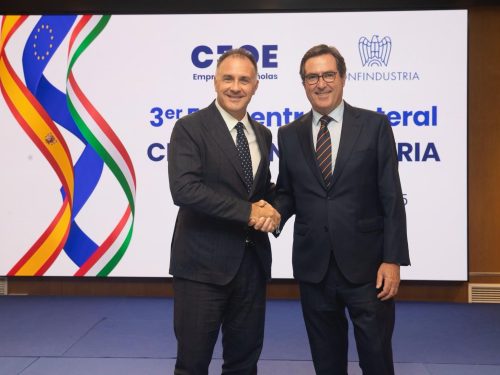Start of 2025 with expensive energy and risk of duties. Services still good, industry better, exports bad.
Friday 17 January 2025
Share on
Conflicting thrusts. 2025 opens with rising energy prices, weighing on inflation and business costs, and fears of tariffs on already weak exports. But the fall in rates, which eases financial conditions, and the implementation of the NRP, which can no longer be postponed, will continue. For Q4 2024, GDP in Italy is estimated to have been sluggish between modest growth in services and industry still struggling.
Inflation up in Europe. Consumer energy prices rose by an annual +0.1% in December from -6.1% in September, bringing inflation to +2.4%, from +1.7%, with core unchanged. In Italy, inflation was stable at +1.3%: core slowed (+1.6% from 1.8%), but energy prices fell less (-2.8%, from -5.5%).
Rates: ECB more cautious. After the rate cut in December (to 3.00%), the ECB does not seem worried about inflation, but markets now expect less of a fall (-0.50% over the year, instead of -1.00%). In Italy, the BTP rose little (3.52% in January), with the spread over the Bund almost unchanged (+1.08). Bank rates are falling (4.53% in November for companies, from 5.48% at the beginning of 2024). Credit is recovering for households, with loans stabilised in annual terms (from -0.2% in October), but is down for businesses (-3.7%).
Services go up. The RTT index (CSC-TeamSystem) reports a rebound in services turnover in November and growth in Q4. In December, the PMI returned to the expansionary area (50.7 from 49.2) and business confidence in the sector also rebounded. That of tourism enterprises is at its highest, even though foreigners' spending in October posted its first decline since 2024 (-5.9% per year).
Industry: timid lights. Production in November (+0.3%) rose on the month, following October's marginal recovery, and now the change in Q4 is +0.1% (-0.5% in Q3, 6 consecutive quarters of decline). The modest recovery is confirmed by the rise in the HCOB PMI in December, still at recessionary levels (46.2 from 44.5). The RTT industry, on the other hand, points to a declining Q4 for turnover.
Falling investments. December saw a moderate rise in business confidence (95.3, from 93.2). On the other hand, demand, as measured by orders for goods, fell (balance at -22.5, from -21.9), both on the domestic and foreign markets. Moreover, investment conditions worsened in Q4 (-11.3 from -7.7; Bank of Italy survey). Overall, the investment picture remains weak at the end of 2024.
Consumption: downward correction. The decline in retail sales continued in November (-0.6% in volume), as in October (-1.0% the change in Q4); both food and non-food goods were down. Household confidence, down in all months of the quarter, also confirmed the correction in consumption, after the jump in Q3 due to the partial return of the savings rate (9.2% from 10.0%).
Almost at a standstill in the labour market. Employment growth almost stopped at the end of 2024: +0.1% in October-November over Q3 (after +0.4%). At the same time, the sharp decline in jobseekers (-6.6%) signals a smaller labour force, which could limit future employment growth prospects.
Falling exports. Italian goods exports remained weak in Q4 (-0.2% in October-November on Q3). Negative dynamics in EU markets (-0.9%), including Germany and France. Slight increase outside the EU (+0.6%): good in the UK and Turkey, bad in the USA (-11.0% year-on-year in November) and China (-19.2%). Strong declines in transport equipment (-17.3%) and textiles-clothing-footwear (-9.0%). The outlook remains weak, according to foreign manufacturing orders in December, also for world trade. Significant risks are posed by possible US duties, the second destination of Italian exports with over 22% of non-EU exports.
Eurozone: heterogeneous dynamics. In November, European industry showed a wide heterogeneity: Germany reared its head again in production (+1.3%) and France recorded a tenuous positive change (+0.2%), but in both countries Q4 acquisitions remained negative; conversely, Spain declined (-1.5%), but thanks to the October jump it remained in positive territory in quarterly terms. The development of confidence and employment expectations in the Eurozone in December is not encouraging.
USA: industry bad, consumption good. Industrial production in November remained down (-0.1%), for the third month, outlining a negative Q4 (-0.7% gained, -0.1% in Q3). Indicators signalled further weakness in December: the Chicago index continued its slump (36.9, from 40.2), the ISM (49.3) and the manufacturing PMI (49.4) remained recessionary. On the other hand, the employment trend was good (+256,000 in December), which continues to fuel US consumption (+0.4% retail sales in December).
China: export boom. Chinese exports accelerated in December (+10.7% year-on-year, from +6.7%). Imports also grew (+1.0%), easing demand-side concerns, although domestic consumption fragilities remain. China's trade surplus reached USD 104.8 billion last month (992 total in 2024); the trade surplus with the US increased to USD 33.5 billion (from USD 29.8): Chinese companies' fears of higher trade barriers in the coming months contributed to this result.
Gas prices rise, electricity too expensive in Italy.
Step on the gas. The price of gas in Europe (FTT) in January rose further, to 48 euro/mwh (from 45), touching 50 on some days. The continued rise from the lows reached in February 2024 (EUR 26) brought the overall increase to +85.5%, although levels remain well below the abnormal peaks of 2022. The price of oil also rose in early 2025 ($77 per barrel, up from $74) although, after last year's downward trend, the price remains below the spring 2024 peak ($90).
Why is gas more expensive? The increase was fuelled by the closure at the beginning of the year of the gas pipeline from Russia via Ukraine to Europe, which had remained operational despite the three-year war between the two countries. This triggered fears that, in those European countries that still imported gas from Russia (e.g. Slovakia, Austria), gas stocks would not be sufficient to sustain winter consumption. A similar fear, but more moderate and less widespread, than the one triggered at the beginning of the war in 2022.
Italy safe on gas. In Italy, gas imports have decreased markedly since the start of the Russia-Ukraine conflict (49 mmc in the first 10 months of 2024, from 60 in the same period of 2021, -17.9%; MASE data). This is due to the sharp reduction in domestic gas consumption in those years (48 mmc, from 59, -19.0%). Moreover, with the significant diversification of supplier countries, Italy now imports, proportionally, more from North Africa (18 mmc) and Azerbaijan (8 mmc), but also liquefied gas arriving by ship, from Qatar and partly from the USA, while imports from Russia have been reduced to marginal volumes.
But the impact on electricity is immediate. The increase in gas prices, which is occurring due to the aforementioned fears in several European countries, does, however, immediately push up the price of electricity in Italy as well, although these fears are unfounded here. On the Italian electricity exchange, the PUN in January 2025 is quoted at 139 euro/mwh on average, up from 88 in February 2024. This is therefore a price increase of +57.9% in about one year.
Historically more expensive electricity in Italy. A comparison with power exchanges in other EU countries shows that the Italian PUN is consistently higher than the price in Germany (108 euros in December), France (98) and Spain (111). According to the available data, the price in Italy at the beginning of 2025 is also higher than in the USA (61 euros/mwh) and Japan: this penalises the international competitiveness of our economy.
Impact on companies' balance sheets. If inflation proves to be persistent, there is a risk that the costs incurred by Italian and European companies for energy, understood as electricity and gas, oil and refined products (fuels), will rise markedly. The greatest impact would be on industry, which is already in difficulty for other reasons, and in particular on energy intensive sectors (chemicals, non-metallic minerals, metallurgy, paper). Only some companies are protected by medium- to long-term supply contracts, which postpone inflation.
Short-term push on inflation. For households, inflation will rise mechanically, with core prices (i.e. net of energy and food) being equal. Energy, in fact, counts for about 10% in the basket of goods and services from which the price index (NIC) is constructed. Thus, the arithmetic impact of an energy price increase at source, on commodities, which usually occurs in the NIC with a lag of one month, is traditionally very significant. Not to mention possible cascading effects of energy costs in the determination of other prices. Higher inflation, eroding real income, could dampen consumption.
Electricity market to be reformed. This makes it clear, as was already the case in 2022, that the electricity price in Italy is too much based on the European gas price. The correlation between the two prices is very high (99% in January 2019-25). There is an increasing urgency to loosen this close link, which is regulatory in nature, to let the electricity price also be based on the (lower) costs of renewable generation. The European cap on the gas price, on the other hand, is not a solution because, in the face of current price increases, it is 'not stringent', being set too high (180 euro mwh).





















